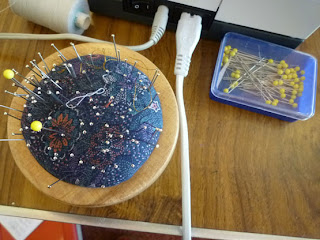




 Some superstitions about pins (pins could be about either good luck or bad luck):
Some superstitions about pins (pins could be about either good luck or bad luck):"See a pin and pick it up, and all the day you'll have good luck; see a pin and let it lie, sure to rue it by and by" -- this is said to come from the frugal days when pins were manufactured by hand and thus weren't the disposable, trifling commodity they are today.
Never lend a pin to a friend lest it prick the friendship. ("Nadeln verstechen die Freundschaft" - as my mother used to say.)
A couple that are new to me:
A bent or crooked pin is thrown into a wishing well for good luck.
Remove a needle or pin from the packet and prick the recipient before giving it to them.
Other manifestations are the practice of sticking pins in wax effigies of enemies, and putting pins in church gates or stiles over which a body has passed.
"Pin money" was very important to women in centuries past, before buttons and zips fastened clothes and instead clothes were pinned together. Queen Elizabeth I went through 60,000 pins a year! Nowadays the term refers to money a woman could spend without reference to her husband.
Pin-making began in England in the 1570s. Pins were made by sharpening a straight piece of wire and winding a thinner-gauge wire around the other end, which was hammered on to make the head. Solid pins were invented in 1824.
Finally, two stories of people with a bizarre fascination for pins:
Pin Tommy walked the streets of Derby in the 1830s. Every pin he found or was given was added to his clothing until it was like a suit of armour. It was said that he would rather go hungry than swop one of his pins for food.
Kitty Hudson (also called the human pincushion) was born in Arnold, near Nottingham, in 1765. She developed a habit of swallowing pins, and in fact could not get to sleep without pins in her mouth. She was finally admitted to hospital and over a long period of time, pins, needles, and pieces of bone were removed from all over her body. On being discharged she married, had nineteen children who all died, was widowed, remarried and eventually settled in South Wingfield, Derbyshire. For the rest of her life, pins would occasionally erupt from her skin.
No comments:
Post a Comment